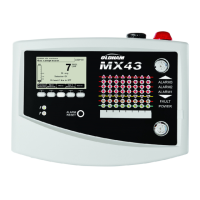6 – Digital Modules 27
Swiches
(On: 1; OFF: 0)
Switches
(ON = 1; OFF = 0)
Module
address
1 2 3 4 5
M odule
Address
1 2 3 4 5
1 1 0 0 0 0 17 1 0 0 0 1
2 0 1 0 0 0 18 0 1 0 0 1
3 1 1 0 0 0 19 1 1 0 0 1
4 0 0 1 0 0 20 0 0 1 0 1
5 1 0 1 0 0 21 1 0 1 0 1
6 0 1 1 0 0 22 0 1 1 0 1
7 1 1 1 0 0 23 1 1 1 0 1
8 0 0 0 1 0 24 0 0 0 1 1
9 1 0 0 1 0 25 1 0 0 1 1
10 0 1 0 1 0 26 0 1 0 1 1
11 1 1 0 1 0 27 1 1 0 1 1
12 0 0 1 1 0 28 0 0 1 1 1
13 1 0 1 1 0 29 1 0 1 1 1
14 0 1 1 1 0 30 0 1 1 1 1
15 1 1 1 1 0 31 1 1 1 1 1
16 0 0 0 0 1 32 0 0 0 0 0
Table 5: Addressing table (address depends on switch positions).
Remarks:
■ The physical address of a module (1 to 32) must be identical to the address
stated on the configuration program COM43 in the central unit.
■ During module replacement, all the configuration switches of a new module
must be positioned in the same configuration as those of the the previous
module.
■ The 6 switches (
FRAME FILLING/REMPLISS TRAME) and 7 (DELAY/TEMPORISATION)
must be set to OFF (options unused).
■ An analog-input module systematically takes 8 addresses.
End of line Resistor
Solely for the last module of each line,
set switch no.8 (
EOL
RESISTOR/RESISTANCE F.D.L.
) to ON or set
the jumper of the analog input PCB to
Closed.
006
Figure 16: End of line resistor switch in
position “ON”.

